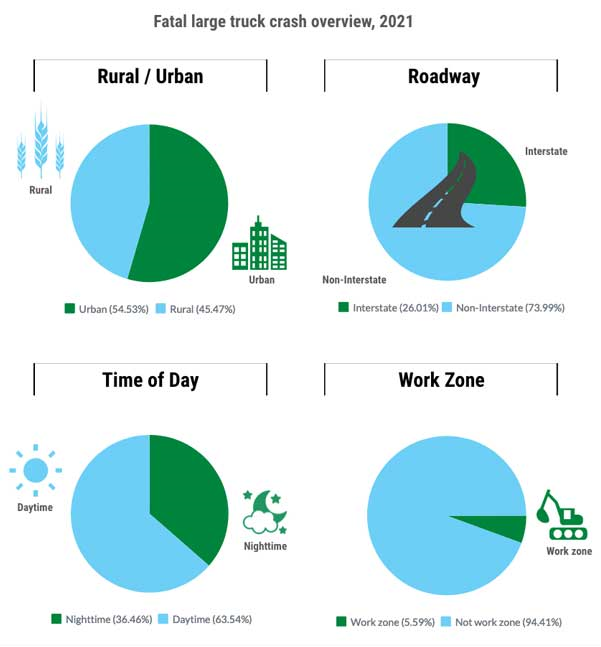Just because you can see them doesn’t mean they can see you.
Large trucks (and not just 18-wheelers!) have different challenges on public roadways.
Understanding Big Trucks: What Vehicles Are Considered Trucks?
Trucks encompass a broad category of vehicles designed primarily for transporting goods or materials. While the term "truck" can refer to various configurations and sizes, some common examples include:
- Semi-Trucks (Tractor-Trailers): Also known as "big rigs" or "18-wheelers," semi-trucks consist of a tractor unit (the cab) attached to one or more trailers. These trucks are often used for long-haul transportation and can weigh up to 80,000 pounds when fully loaded.
- Delivery Trucks: These smaller trucks are typically used for local or regional deliveries, such as transporting packages, groceries, or commercial goods. Delivery trucks come in various sizes, from light-duty vans to medium-duty box trucks.
- Dump Trucks: Designed for hauling loose materials such as sand, gravel, or construction debris, dump trucks feature an open-box bed that can be raised to unload cargo. These trucks are commonly used in construction, mining, and landscaping industries.
- Garbage Trucks: Also known as refuse trucks or waste collection vehicles, garbage trucks are specialized vehicles used for collecting and transporting municipal solid waste. They come in different configurations, including front loaders, rear loaders, and side loaders.
- Tow Trucks: Used for towing disabled or illegally parked vehicles, tow trucks come equipped with specialized equipment such as winches, booms, or flatbeds. They play a crucial role in roadside assistance and vehicle recovery operations.
- Emergency Responders: Vehicles such as firetrucks and certain types of ambulances need the same safety considerations as “traditional” trucks. Nearly 60% of ambulance accidents and 70% of firetruck accidents happen while in emergency use. Being aware of their movements and giving them an abundance of space isn’t just safer, it’s the law.
Just How Dangerous are Crashes with Large Trucks?
According to the National Safety Council’s (NSC) nationwide report on large truck crash statistics for 2021, large trucks accounted for:
- 9% of all vehicles involved in fatal crashes
- 5% of all registered vehicles
- 10% of total vehicle miles traveled
Additionally, the NSC explains that nationally the risk conditions for fatal large truck crashes are as follows:

Click here to review additional NSC large truck crash and accident statistics.
Tips for Sharing the Road Safely with Large Trucks
When it comes to road safety, sharing the highways with large trucks requires a heightened level of awareness and caution. Not only do their size and lack of maneuverability make trucks exceptionally dangerous; tight delivery deadlines, fatigued drivers and poorly maintained trucks can also add to the risks. With that cautionary information in mind, here are some essential tips for safely sharing the road with big trucks:
- Stay Visible: Big trucks have larger blind spots (or "no-zones") compared to passenger vehicles. Avoid lingering in these blind spots, which typically include areas directly behind, alongside, and in front of the truck. Just because you can see them doesn’t mean they can see you.
- Maintain a Safe Following Distance: Trucks require more time and distance to come to a complete stop due to their size and weight. Maintain a safe following distance of at least four seconds to allow ample time to react to sudden stops or emergencies.
- Use Caution When Passing: When passing a big truck, do so quickly and safely. Signal your intentions early and accelerate to pass promptly. Avoid passing on the right whenever possible, as this is a truck's largest blind spot.
- Be Predictable: Use your turn signals, brake lights, and headlights to communicate your intentions clearly to truck drivers. Avoid sudden lane changes or erratic maneuvers that can catch truck drivers off guard.
- Respect Truck Size and Speed: Remember that big trucks have limited maneuverability and may require extra space to make turns or navigate tight spaces. Give trucks plenty of room to maneuver and avoid cutting them off or impeding their progress.
- Stay Alert: Always stay focused on the road ahead and avoid distractions such as cell phones, eating, or adjusting the radio.
Sharing the Road Responsibly
By understanding the unique characteristics of big trucks and following these essential tips, you can help ensure safer roadways for all users. Whether passing on the highways or sharing urban streets, you can never be too careful when trucks are on the road.

